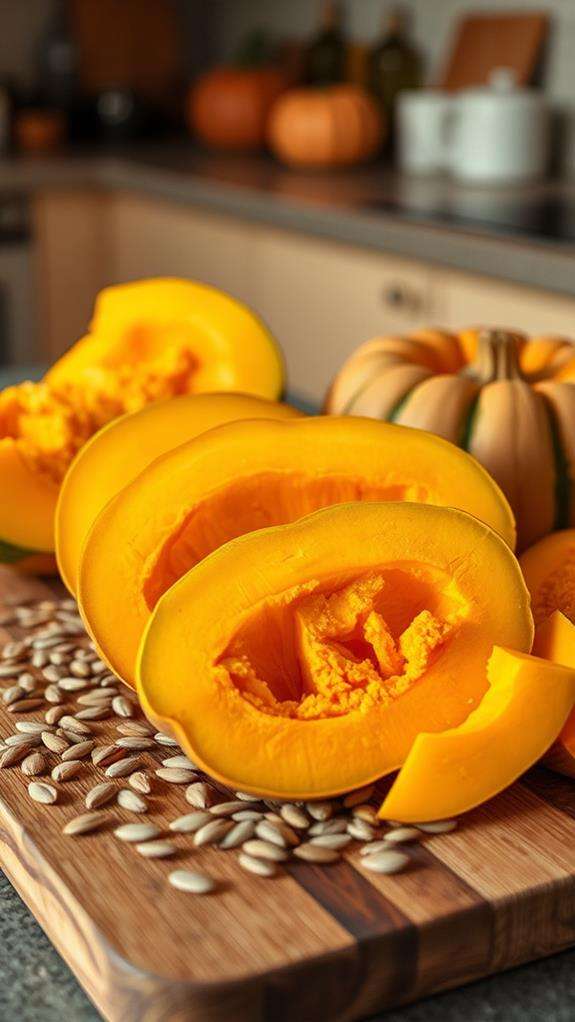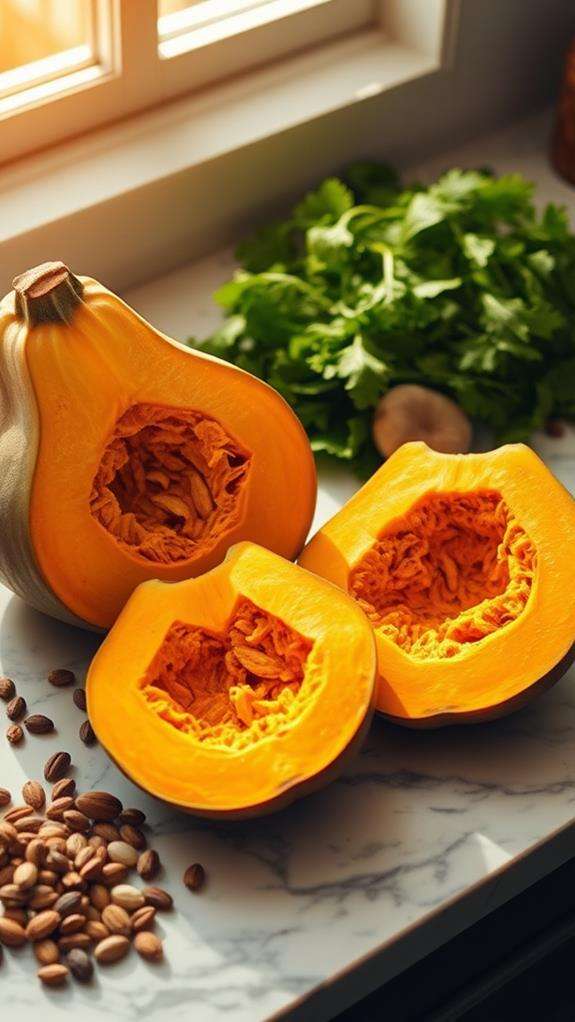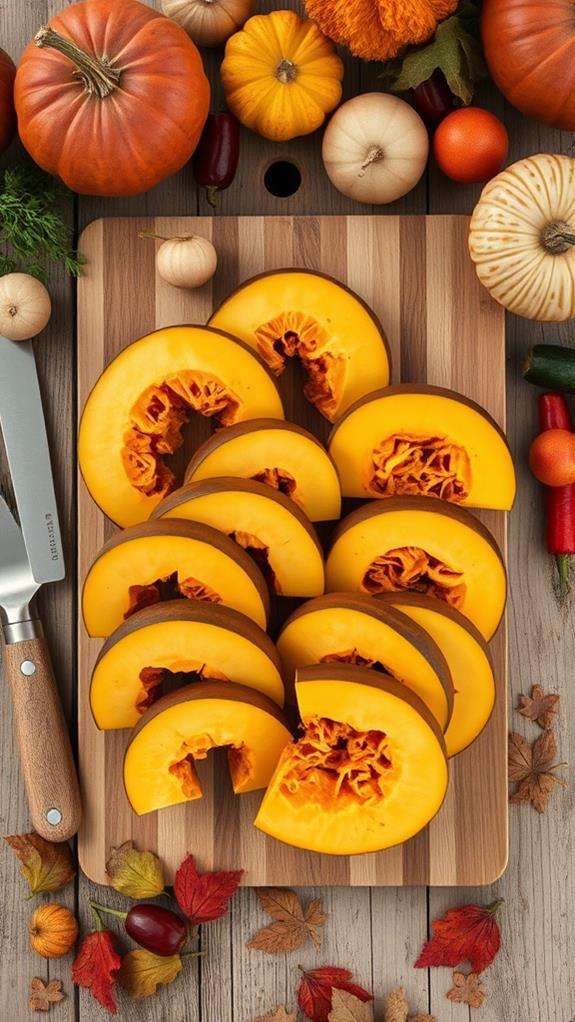Is It Safe to Eat Raw Pumpkin
Raw pumpkin is generally safe to eat and offers numerous health benefits. It's an excellent source of vitamins A and C, potassium, and antioxidants. However, you should take certain precautions. Only consume food-grade pumpkins, not decorative ones, and thoroughly wash the exterior to remove dirt and bacteria. The high fiber content may cause digestive discomfort for some people, so introduce it gradually into your diet. Raw pumpkin can be added to salads or blended into smoothies for a nutritious boost. If you're concerned about potential allergic reactions or have digestive issues, consult a healthcare professional. There's much more to explore about raw pumpkin's nutritional profile and culinary uses.
This post may contain affiliate links. If you make a purchase through these links, I may earn a commission at no additional cost to you. Additionally, portions of this post may be generated using artificial intelligence (AI) technology. While we strive for accuracy, please be aware that AI-generated content may not always be perfect and should be fact-checked when necessary.
The Spatula Scoops
- Raw pumpkin is generally safe to eat when consumed in moderation and properly cleaned.
- Food-grade pumpkins should be used, not decorative ones, to ensure safety for consumption.
- High fiber content in raw pumpkin may cause digestive discomfort for some individuals.
- Thoroughly wash the pumpkin's exterior to remove dirt and potential bacteria before eating.
- Raw pumpkin is nutritious, offering vitamins A and C, potassium, and antioxidants.
Nutritional Profile of Raw Pumpkin

Despite its humble appearance, raw pumpkin packs a powerful nutritional punch. You'll find it's an excellent source of vitamins and minerals, particularly vitamin A, vitamin C, and potassium. These nutrients play indispensable roles in maintaining your eye health, immune system, and heart function. Raw pumpkin is also rich in antioxidants, such as alpha-carotene and beta-carotene, which help protect your cells from damage caused by free radicals. Like corn, pumpkin is versatile and can be used in various applications. It's low in fat and high in carbohydrates, making it a nutritious addition to your diet.
When you're looking to boost your fiber intake, raw pumpkin is a great choice. It's low in calories but high in dietary fiber, which aids in digestion and helps you feel fuller for longer. This makes it an ideal food for weight management and overall gut health. Additionally, raw pumpkin contains a good amount of protein, which is essential for muscle growth and repair. It's also a source of healthy fats, including omega-3 and omega-6 fatty acids, which contribute to brain function and reduce inflammation in your body. The seeds, in particular, are packed with nutrients like zinc and magnesium, further enhancing the pumpkin's nutritional profile.
Safety Concerns and Precautions
Safety first: while raw pumpkin is generally safe to eat, there are a few precautions you should keep in mind. Guarantee you're consuming food-grade pumpkins, not decorative ones, which may be treated with chemicals. Always wash the pumpkin thoroughly to remove any dirt or bacteria. If you're prone to digestive issues, raw pumpkin might cause discomfort due to its high fiber content. Much like handling wild rabbits, it's critical to practice good hygiene when preparing raw pumpkin to prevent potential contamination.
When preparing raw pumpkin, use a sharp knife and stable cutting surface to avoid accidents. Remove all seeds and stringy parts before consumption. If you're new to eating raw pumpkin, start with small amounts to see how your body reacts. Some people may experience mild allergic reactions, so be aware of any unusual symptoms.
For those with compromised immune systems or pregnant women, it's best to consult a healthcare professional before adding raw pumpkin to your diet. While rare, there's a slight risk of foodborne illnesses from consuming any raw vegetable. To mitigate this, consider blanching the pumpkin briefly in boiling water before eating. This process can help reduce potential pathogens while maintaining most of the nutritional benefits.
Potential Health Benefits

While precautions are important, raw pumpkin offers several potential health benefits. You'll find that this nutrient-dense vegetable is packed with vitamins and minerals. It's an excellent source of vitamin A, which supports your eye health and immune system. Raw pumpkin also contains vitamin C, an antioxidant that helps protect your cells from damage. Similar to omega-3 fatty acids found in salmon skin, the nutrients in raw pumpkin can contribute to overall health and well-being.
You'll get a good dose of fiber from raw pumpkin, which aids digestion and promotes feelings of fullness. This can be particularly beneficial if you're trying to manage your weight. The vegetable is also rich in potassium, supporting heart health and muscle function.
Raw pumpkin seeds, often consumed alongside the flesh, are a nutritional powerhouse. They're high in magnesium, zinc, and healthy fats. These nutrients contribute to bone health, immune function, and heart health.
Additionally, pumpkin contains beta-carotene, a precursor to vitamin A that gives the vegetable its orange color. This compound has been linked to reduced risk of certain cancers and may offer protection against age-related eye diseases. By incorporating raw pumpkin into your diet, you're potentially boosting your overall health and well-being.
Digestibility and Gut Health
When it comes to digestibility and gut health, raw pumpkin can be a mixed bag. Raw pumpkin contains a high amount of fiber, which can be beneficial for your digestive system. However, its raw form may be harder for your body to break down compared to cooked pumpkin. The insoluble fiber in raw pumpkin can help promote regular bowel movements and prevent constipation, but it might also cause bloating or gas in some people.
Raw pumpkin's impact on your gut health depends on various factors:
- Your individual digestive system's sensitivity
- The amount of raw pumpkin consumed
- Your overall diet and fiber intake
- The presence of any existing digestive issues
- The ripeness and quality of the pumpkin
While raw pumpkin can provide prebiotic benefits, supporting the growth of beneficial gut bacteria, it's important to introduce it gradually into your diet. If you're not used to consuming raw pumpkin, start with small amounts to allow your digestive system to adjust. Remember, everyone's gut microbiome is unique, so what works for one person may not work for another. If you experience persistent digestive discomfort after eating raw pumpkin, consider consulting a healthcare professional or nutritionist for personalized advice.
Culinary Uses for Raw Pumpkin

You'll find that raw pumpkin can be used in various culinary applications, from salads to beverages. For an invigorating twist, try incorporating thin slices or small cubes of raw pumpkin into your favorite salad recipes, adding a unique crunch and subtle flavor. If you prefer drinks, you can experiment with juicing raw pumpkin or blending it into smoothies, which can be a wholesome way to enjoy this versatile vegetable.
Raw Pumpkin Salad Recipes
Raw pumpkin adds a delightful crunch and mild flavor to salads, making it a versatile ingredient in fresh, healthy dishes. When preparing raw pumpkin salads, you'll want to choose a small, tender pumpkin and peel it carefully. Slice the pumpkin into thin strips or small cubes for the best texture. You can pair raw pumpkin with a variety of ingredients to create delicious salads that are both nutritious and visually appealing.
Here are some ideas for raw pumpkin salad recipes:
- Pumpkin and apple slaw with a tangy yogurt dressing
- Mediterranean-style salad with raw pumpkin, feta, and olives
- Asian-inspired salad featuring raw pumpkin, edamame, and sesame seeds
- Autumn harvest salad with raw pumpkin, cranberries, and pecans
- Superfood salad combining raw pumpkin, kale, and quinoa
When creating your raw pumpkin salad, consider the balance of flavors and textures. You'll want to include ingredients that complement the mild taste of raw pumpkin. Acidic dressings, like those made with citrus or vinegar, can help to brighten the flavor profile. Don't forget to incorporate herbs and spices to add depth to your salad. By experimenting with different combinations, you'll discover your favorite raw pumpkin salad recipes.
Juice and Smoothie Options
Beyond salads, raw pumpkin can be incorporated into invigorating juices and nutrient-packed smoothies. You'll find that pumpkin's mild flavor blends well with other ingredients, making it a versatile addition to your beverage repertoire. To create a pumpkin juice, you can combine raw pumpkin chunks with apples, carrots, and a dash of cinnamon in a juicer. This mixture yields a vital drink rich in vitamins A and C.
For smoothies, raw pumpkin pairs excellently with bananas, Greek yogurt, and a splash of almond milk. You might also consider adding a scoop of protein powder to boost the nutritional content. When preparing these drinks, it's indispensable to thoroughly clean the pumpkin's exterior to remove any dirt or bacteria. Remember to cut away the tough outer skin before blending or juicing.
To optimize these recipes for search engines, you'll want to use keyword-rich titles and meta descriptions. For instance, "Raw Pumpkin Smoothie: A Nutrient-Dense Fall Favorite" could be an SEO-friendly title. Additionally, including long-tail keywords like "healthy raw pumpkin juice recipe" in your content can improve its visibility in search results.
Alternatives to Eating Raw Pumpkin
If you're looking for alternatives to eating raw pumpkin, you've got plenty of tasty options. You can try roasting pumpkin seeds for a crunchy snack that's packed with nutrients. For those who prefer cooked pumpkin, there's a wide array of dishes like soups, stews, and roasted pumpkin slices that bring out the vegetable's natural sweetness. If you've got a sweet tooth, pumpkin-based baked goods like pies, muffins, and breads offer a comforting way to enjoy this versatile squash.
Roasted Pumpkin Seeds
One delicious alternative to eating raw pumpkin is roasting the seeds. After you've carved your jack-o'-lantern or prepared a pumpkin for cooking, don't throw away those seeds. They're packed with nutrients and can be transformed into a tasty snack. To roast pumpkin seeds, you'll need to clean them thoroughly, removing any pulp. Pat them dry, then toss them with a bit of oil and your favorite seasonings. Spread them on a baking sheet and roast at 325°F (165°C) for about 45 minutes, stirring occasionally.
Here are some tips to enhance your roasted pumpkin seed experience:
- Experiment with different spice blends, like cinnamon sugar or savory herbs
- Store roasted seeds in an airtight container to maintain freshness
- Use them as a crunchy topping for salads or soups
- Try incorporating them into homemade granola or trail mix
- Grind roasted seeds to create a nutrient-rich "flour" for baking
Roasted pumpkin seeds are a versatile ingredient that can add texture and flavor to many dishes. They're rich in magnesium, zinc, and omega-3 fatty acids, making them a nutritious alternative to raw pumpkin. By roasting the seeds, you're not only avoiding potential risks associated with raw pumpkin but also creating a delightful snack or cooking ingredient.
Cooked Pumpkin Dishes
Numerous delicious cooked pumpkin dishes offer safe and tasty alternatives to eating raw pumpkin. You'll find a variety of options that showcase pumpkin's versatility in both savory and sweet recipes. From comforting soups to decadent desserts, there's a pumpkin dish for every palate.
Savory Dishes | Sweet Dishes
—————|—————
Pumpkin Soup | Pumpkin Pie
Pumpkin Risotto | Pumpkin Bread
Roasted Pumpkin | Pumpkin Cheesecake
When preparing pumpkin dishes, you'll want to focus on proper cooking techniques to guarantee food safety and maximize flavor. For soups and purees, you'll need to simmer the pumpkin until it's tender. In baked goods, you'll often use canned pumpkin puree or roasted and mashed fresh pumpkin. Roasting pumpkin brings out its natural sweetness and can be a great side dish or addition to salads. By exploring these cooked pumpkin options, you'll enjoy the nutritional benefits of pumpkin without the potential risks associated with consuming it raw.
Pumpkin-Based Baked Goods
Pumpkin-based baked goods offer a delicious and safe alternative to consuming raw pumpkin. These treats allow you to enjoy the flavor and nutritional benefits of pumpkin without the potential risks associated with raw consumption. When baked, pumpkin's nutrients become more easily digestible, and any harmful bacteria are eliminated through the cooking process.
You'll find a wide variety of pumpkin-based baked goods to satisfy your cravings:
- Pumpkin pie
- Pumpkin bread
- Pumpkin muffins
- Pumpkin cookies
- Pumpkin cheesecake
These baked goods often incorporate spices like cinnamon, nutmeg, and ginger, enhancing the pumpkin's natural flavor profile. They're not only tasty but also provide a good source of fiber, vitamins, and minerals. When baking with pumpkin, you can use canned puree or prepare your own from fresh pumpkin. If using fresh pumpkin, verify it's properly cooked and pureed before incorporating it into your recipe.
Frequently Asked Questions
Can Eating Raw Pumpkin Seeds Cause Intestinal Parasites?
You don't need to worry about intestinal parasites from eating raw pumpkin seeds. These seeds are generally safe to consume raw and don't harbor parasites that can infect humans. In fact, they're a nutritious snack packed with protein, healthy fats, and minerals. However, it's always a good idea to wash them thoroughly before eating, especially if they're straight from a pumpkin. If you have any concerns, you can always roast them for added safety and flavor.
Is Raw Pumpkin Skin Edible, or Should It Be Removed?
You can eat raw pumpkin skin, but it's not always recommended. While it's technically edible, the skin can be tough and fibrous, making it difficult to chew and digest. It's best to remove the skin, especially from larger pumpkins, as it can be bitter and less palatable. However, the skin of smaller, younger pumpkins may be more tender and easier to eat. If you choose to eat the skin, make sure to wash it thoroughly to remove any dirt or pesticides.
How Long Can Raw Pumpkin Be Stored Before It Spoils?
You've got a golden opportunity to guarantee your pumpkin's shelf life. Raw, uncut pumpkins can last 2-3 months at room temperature. Once you've carved into that orange beauty, refrigerate the pieces in airtight containers for 3-5 days. For longer storage, you can freeze raw pumpkin chunks for up to 6 months. Keep an eye out for signs of spoilage like soft spots, mold, or off-odors. Proper storage verifies you'll have fresh pumpkin for your culinary adventures.
Can Raw Pumpkin Be Fed to Pets Like Dogs or Cats?
You can feed raw pumpkin to your pets, but it's important to do so in moderation. For dogs, raw pumpkin can be a healthy treat, providing fiber and nutrients. However, you shouldn't give them the stem, skin, or seeds. Cats can also eat small amounts of raw pumpkin, but they're less likely to enjoy it. Always introduce new foods gradually and watch for any digestive issues. If you're unsure, consult your veterinarian before adding raw pumpkin to your pet's diet.
Does Raw Pumpkin Have Any Potential Interactions With Medications?
You should be aware that raw pumpkin can potentially interact with certain medications. While it's generally safe, pumpkin contains compounds that may affect blood sugar levels and blood thinning medications. If you're taking diabetes medication or anticoagulants, it's wise to consult your doctor before consuming raw pumpkin. Additionally, pumpkin's high fiber content could impact the absorption of some drugs. Always inform your healthcare provider about your diet, including raw pumpkin consumption, to guarantee safe medication management.
Conclusion
You've now explored the ins and outs of eating raw pumpkin. While it's generally safe, you'll want to weigh the pros and cons before diving in. Like a double-edged sword, raw pumpkin offers nutritional benefits but may pose digestive challenges for some. Consider incorporating small amounts into your diet or opting for cooked alternatives. Remember, moderation is key. If you're unsure, it's always wise to consult with a healthcare professional before making significant dietary changes.





